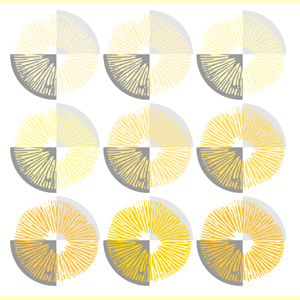
Subtle variations in the shade of the spore print are important in identifying agaric genera. Assess spore print colour from a fresh, thick spore deposit on pure white paper. Dark paper can be useful to see where white or pale spores have fallen, but it can be difficult to differentiate between pure white and other very pale shades (so at least use half white, half dark paper). Spore print colour may change once the spore print has dried out (green spore prints often change to brown).
Some idea of the spore print colour can be gained from the colour of mature lamellae, but there are enough exceptions to this that care is needed. Examples of genera which have strongly coloured lamellae but a white or pale spore print are Anthracophyllum and Laccaria. White or pale lamellae can occasionally give a surprisingly strongly coloured spore print, as is the case for the pink spore print produced by the Rhodocollybia butyracea group.
Spore print colours are often treated as distinct and mutually exclusive categories, but some of the categories are very close or even overlap. If you cannot match the colour exactly to one of the categories (such as when there is only a thin spore print), choose two or more options.
Colour charts are referred to in capitals: BFF (Royal Botanic Gardens Edinburgh, 1969), METHUEN (Kornerup & Wanscher, 1978) and RAYNER (Rayner, 1970). For comparison against the METHUEN colour charts, for each spore print colour category, we give the range of pages that the colours from the category can be found on, and then a sample of specific colour chips from within these pages that match the shade of the particular category.
